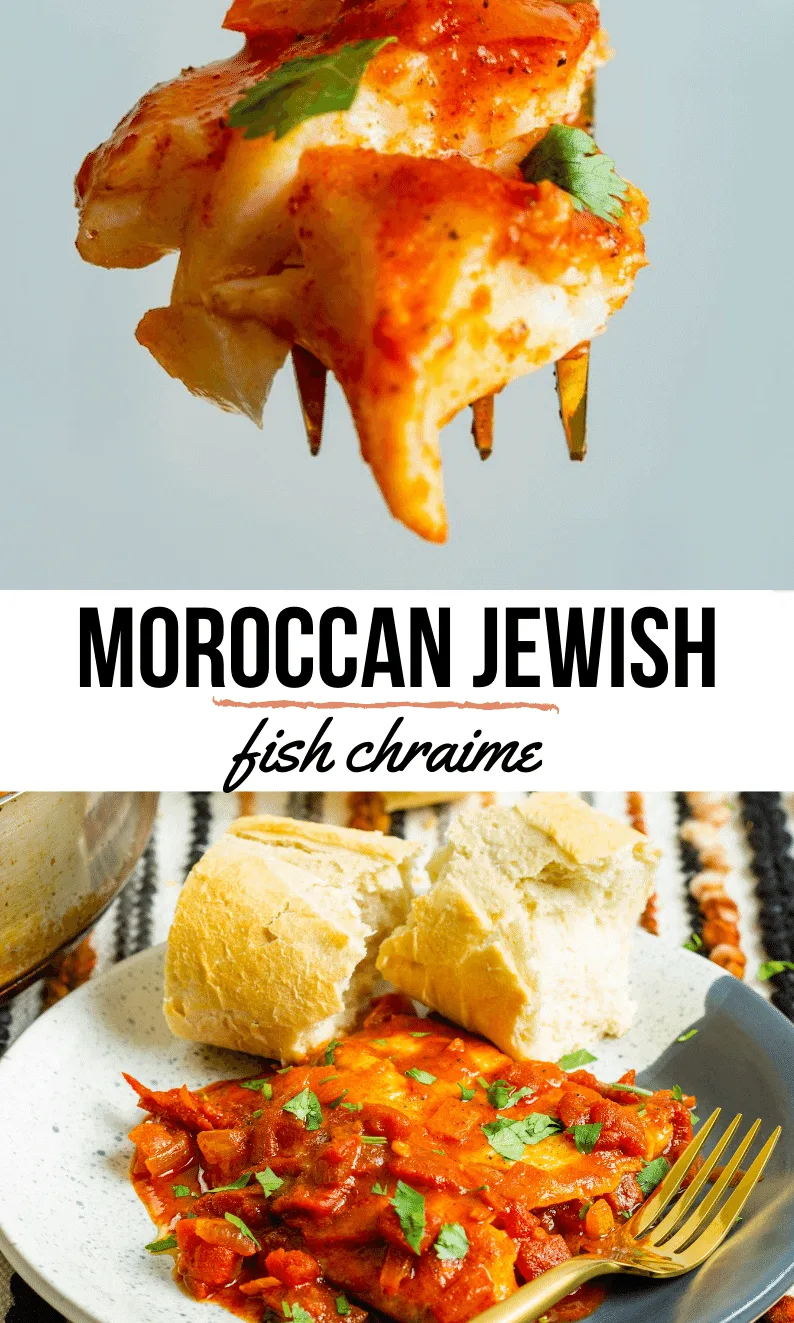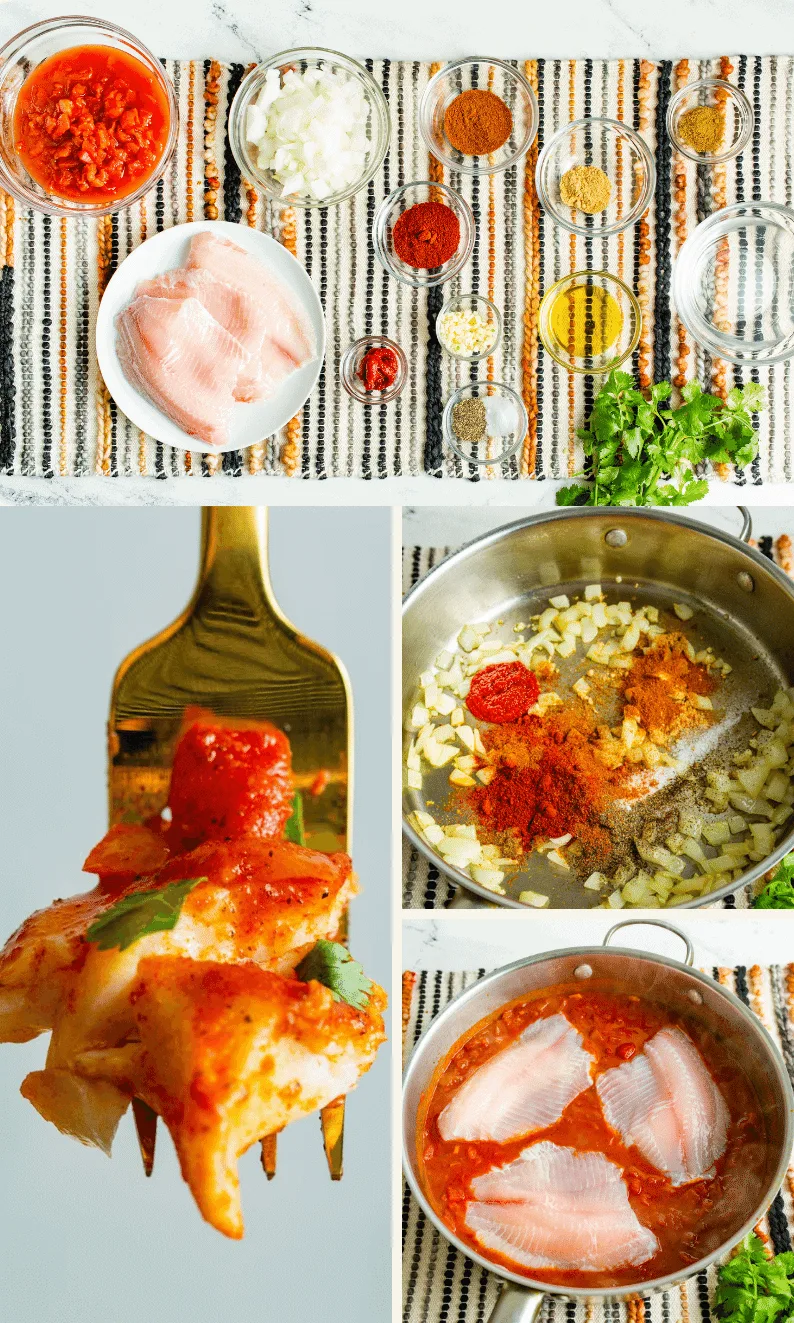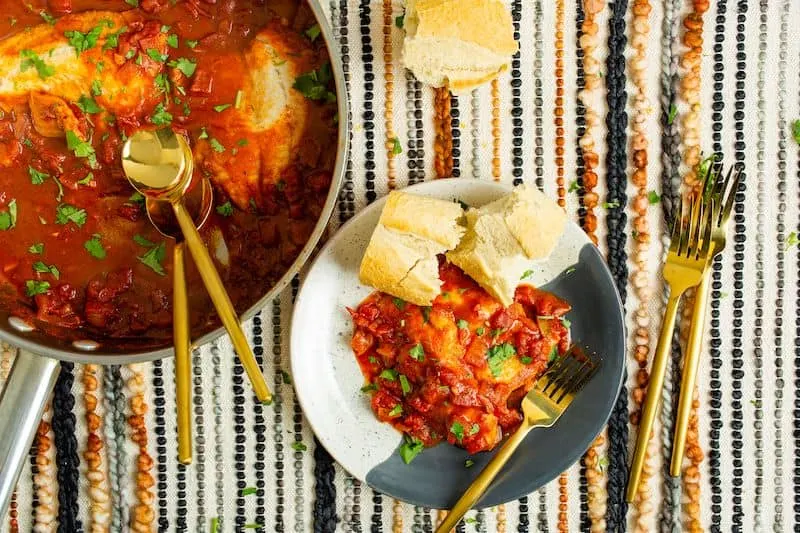In my quest to diversify the Moroccan recipes that I share, Jewish Moroccan fish chraime is one of the recipes that are a part of my research. To be fair, this is not a recipe I have ever eaten in Morocco. Many Moroccan Jewish and Moroccan Muslim recipes are very similar, if not exactly the same.
That being said, there are also recipes that are unique to Moroccan Jews – those are the ones that intrigue me. Like dafina, chraime is a dish that is prepared for Shabbat by Sephardic Jews. It’s also sometimes made for holidays like Passover.

If you want a meal that is easy to put together and can be reheated fairly simply – this is it! Feel free to use any type of firm white fish that you have locally available.
You also can adjust this for your own flavor preferences. Some people like this really spicy while others prefer a more mild dish. You can add hot peppers when cooking or serve with harissa on the side for people to adjust on their own.
What is chraime?
Chraime has deep roots in the North African Jewish community, with its origins tracing back to the Jewish Sephardic heritage that flourished in Morocco. This dish was commonly prepared for special occasions and family gatherings, reflecting the rich culinary traditions that Jewish families brought with them to Morocco.
Over time, chraime became a staple, especially among the Jewish communities in coastal cities like Casablanca and Essaouira, where fresh fish was readily available.
Chraime is not just a meal; it’s a symbol of tradition, celebration, and the blending of cultures. While it is primarily associated with Jewish Moroccan cuisine, variations of chraime can be found throughout North Africa, with each region and family adding its unique touch.
In Jewish households, the dish is often prepared on Fridays for Shabbat, filling homes with its inviting aroma, or served as a festive dish during Passover, where it is enjoyed with matzo instead of bread.

Serving Suggestions
Jewish Moroccan fish chraime is traditionally served with warm challah bread, which is perfect for soaking up the flavorful sauce. This dish also pairs beautifully with couscous, rice, or a simple salad for a balanced meal. For a more festive presentation, serve the chraime in a large, shallow dish, garnished with extra fresh cilantro and lemon wedges on the side. This not only adds a burst of color but also allows guests to adjust the tartness to their liking.
Variations and Adaptations
While the classic recipe is a favorite, there are many ways to put your spin on chraime. For a different flavor profile, consider adding sliced bell peppers or onions to the sauce. You can also experiment with different types of fish, such as salmon or tilapia, depending on what’s available. For those who prefer a less spicy version, simply reduce the amount of hot paprika or omit the red pepper flakes altogether.
Vegetarians can enjoy a chraime-inspired dish by substituting the fish with tofu or hearty vegetables like eggplant or zucchini. Prepare the sauce as usual and add the tofu or vegetables, cooking until they are tender and well-coated with the sauce.
Tips for Making Ahead and Storing Leftovers
Chraime is a great make-ahead dish, as the flavors continue to develop over time. To prepare in advance, make the sauce and store it in the refrigerator for up to two days. When ready to serve, reheat the sauce and add the fish, cooking until it’s done.

Leftovers can be stored in an airtight container in the refrigerator for up to three days. To reheat, gently warm the chraime on the stovetop over low heat, adding a bit of water if necessary to thin the sauce. Chraime can also be frozen for up to a month; simply thaw it in the refrigerator overnight and reheat as needed.
How to Make Jewish Moroccan Fish Chraime

Jewish Moroccan Chraime
This easy to make shabbat dish includes fish and tomatoes. Adjust the spices to make it your own.
Ingredients
- 1 lb white fish, like cod or halibut
- 1/2 of a white onion, chopped
- 1 tsp garlic, minced
- 1/2 jalapeno or other spicy pepper (optional)
- 2 Tbsp olive oil
- 1 Tbsp tomato paste
- 2-3 large tomatoes, diced
- 1 cup water
- 2 Tbsp paprika
- 1/2 Tbsp cayenne pepper
- 1 tsp ginger powder
- 1 tsp cumin powder
- 1 tsp salt
- 1 tsp pepper
- 1 palmful parsley to garnish
Instructions
- Clean the fish (if needed), pat dry, and set aside while preparing the sauce.
- Heat the oil on low in a skillet.
- Sauté the onion and garlic in the oil on medium heat until softened, about 3-4 minutes.
- To the onion mixture add in the spices, salt and pepper, and the tomato paste.
- Next, add in the diced tomato and water and stir well.
- Continue cooking the sauce on low heat with the cover on the pot for 10 minutes.
- Add the fish to the sauce by gently sliding it into the pan. Gently use a spatula and shake the pan to cover the fish with the sauce.
- Cover the pot and leave it alone to cook for an additional 10 minutes.
- The fish can now be served alone, with bread or on top of rice.
Other Recipes to Try for Passover
Passover is a time for celebrating tradition, family, and of course, delicious food. If you’re looking to expand your Passover menu, there are plenty of mouthwatering dishes. From flavorful Sephardic recipes to modern twists on traditional favorites, here are some other recipes to try for Passover that will bring new tastes to your holiday table.
- Moroccan-style Haroset Balls
- Orange and Black Olive Salad with Argan Oil
- Moroccan Slow Cooker Dafina
- Stuffed Artichokes with Lemon Saffron Sauce
- Chicken with Matzo Stuffing
- Sardine Meatball Tajine
More Passover Ideas (Sephardic Inspired)
Jewish Moroccan fish chraime is a dish that captures the heart and soul of Moroccan Jewish cuisine. Its bold flavors and rich history make it a standout at any table, whether you’re celebrating a special occasion or enjoying a comforting family meal. By following this recipe, you can bring a taste of Morocco into your kitchen and experience the vibrant culinary traditions of the Jewish Moroccan community. Pair it with Moroccan bread recipes to complete the authentic experience and truly savor the essence of this rich culinary heritage.